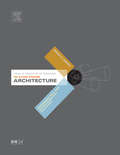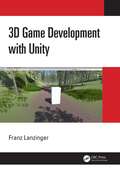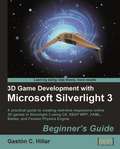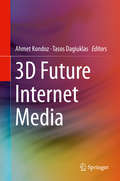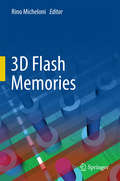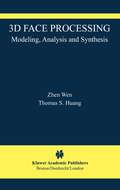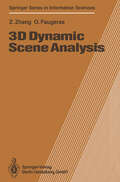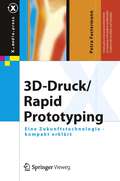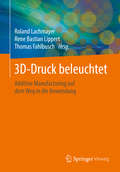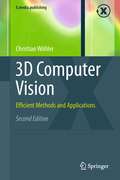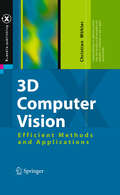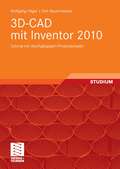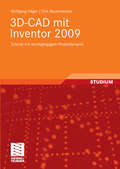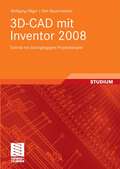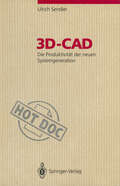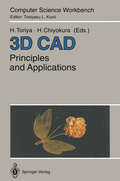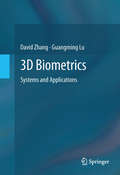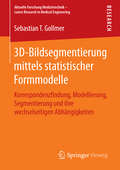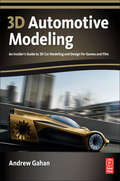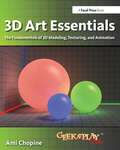- Table View
- List View
3D Game Engine Architecture: Engineering Real-Time Applications with Wild Magic
by David EberlyDave Eberly's 3D Game Engine Design was the first professional guide to the essential concepts and algorithms of real-time 3D engines and quickly became a classic of game development. Dave's new book 3D Game Engine Architecture continues the tradition with a comprehensive look at the software engineering and programming of 3D engines. This book is
3D Game Development with Unity
by Franz LanzingerThis book teaches beginners and aspiring game developers how to develop 3D games with Unity. Thousands of commercial games have been built with Unity. This book combines a practical, step-by-step approach with explanations of the underlying theory that are reinforced with hundreds of screenshots and several larger projects. Building on the knowledge developed in 2D Game Development for Unity, this book uses the Blender software for 3D modelling and texturing, GIMP for 2D art, Audacity for sound effects, and MuseScore for music composition and notation. Readers can follow the step-by-step guides and create an introductory racing game, a 3D maze game, and a 3D FPS adventure game as they progress through the chapters. The book contains numerous color illustrations and online access to easily downloadable game assets, code, and project files. Written to be accessible and easy to follow, this book will be a valuable resource to both beginner and aspiring game developers that want to develop 3D games with Unity. Franz Lanzinger is an independent game developer, author, and pianist. He is the owner of Lanzinger Studio located in Sunnyvale, California. His game development career spans almost 40 years starting with the coin-op classic Crystal Castles at Atari in 1983, continuing with Ms. Pacman and Toobin' for the NES, published by Tengen in 1990. Franz has been an indie game developer since 1991. He worked on SNES Rampart, Championship Pool, and NCAA Final Four Basketball, as well as Gubble for the PC, Mac, and PlayStation. This is Franz's third book about game development. He is currently working on a remaster of Gubble. In his spare time, he is the piano accompanist for the Valley Chorale and the Serendipity Choir. Go to franzlanzinger.com for the latest news about Franz as well as resources for his books.
3D Game Development with Unity
by Franz LanzingerThis book teaches beginners and aspiring game developers how to develop 3D games with Unity. Thousands of commercial games have been built with Unity. This book combines a practical, step-by-step approach with explanations of the underlying theory that are reinforced with hundreds of screenshots and several larger projects. Building on the knowledge developed in 2D Game Development for Unity, this book uses the Blender software for 3D modelling and texturing, GIMP for 2D art, Audacity for sound effects, and MuseScore for music composition and notation. Readers can follow the step-by-step guides and create an introductory racing game, a 3D maze game, and a 3D FPS adventure game as they progress through the chapters. The book contains numerous color illustrations and online access to easily downloadable game assets, code, and project files. Written to be accessible and easy to follow, this book will be a valuable resource to both beginner and aspiring game developers that want to develop 3D games with Unity. Franz Lanzinger is an independent game developer, author, and pianist. He is the owner of Lanzinger Studio located in Sunnyvale, California. His game development career spans almost 40 years starting with the coin-op classic Crystal Castles at Atari in 1983, continuing with Ms. Pacman and Toobin' for the NES, published by Tengen in 1990. Franz has been an indie game developer since 1991. He worked on SNES Rampart, Championship Pool, and NCAA Final Four Basketball, as well as Gubble for the PC, Mac, and PlayStation. This is Franz's third book about game development. He is currently working on a remaster of Gubble. In his spare time, he is the piano accompanist for the Valley Chorale and the Serendipity Choir. Go to franzlanzinger.com for the latest news about Franz as well as resources for his books.
3D Game Development with Microsoft Silverlight 3: Beginner's Guide : A Practical Guide To Creating Real-time Responsive Online 3d Games In Silverlight 3 Using C#, Xbap Wpf, Xaml, Balder, And Farseer Physics Engine
by Gaston C. HillarThis book takes a step-by-step approach to building a complete interactive 3D game using Silverlight and enhancing it through its related technologies. The book focuses on practical examples and has a friendly approach, with the opportunity to learn by experiment and play. It uses illustrations, screenshots, and interactive experiences to understand the most complex topics related to the 3D scenes. This book is designed primarily for C# developers with basic knowledge of the Visual Studio IDE who want to develop online 3D games using Silverlight or create interactive 3D scenes for a web site with animated models. No prior experience in 3D programming, 3D animation, or Silverlight is required. The book is also aimed at 3D developers who want to improve their online content, offering innovative 3D models in action.
3D Future Internet Media
by Ahmet Kondoz Tasos DagiuklasThis book describes recent innovations in 3D media and technologies, with coverage of 3D media capturing, processing, encoding, and adaptation, networking aspects for 3D Media, and quality of user experience (QoE). The main contributions are based on the results of the FP7 European Projects ROMEO, which focus on new methods for the compression and delivery of 3D multi-view video and spatial audio, as well as the optimization of networking and compression jointly across the Future Internet (www.ict-romeo.eu). The delivery of 3D media to individual users remains a highly challenging problem due to the large amount of data involved, diverse network characteristics and user terminal requirements, as well as the user’s context such as their preferences and location. As the number of visual views increases, current systems will struggle to meet the demanding requirements in terms of delivery of constant video quality to both fixed and mobile users. ROMEO will design and develop hybrid-networking solutions that combine the DVB-T2 and DVB-NGH broadcast access network technologies together with a QoE aware Peer-to-Peer (P2P) distribution system that operates over wired and wireless links. Live streaming 3D media needs to be received by collaborating users at the same time or with imperceptible delay to enable them to watch together while exchanging comments as if they were all in the same location.The volume provides state-of-the-art information on 3D multi-view video, spatial audio networking protocols for 3D media, P2P 3D media streaming, and 3D Media delivery across heterogeneous wireless networks among other topics. Graduate students and professionals in electrical engineering and computer science with an interest in 3D Future Internet Media will find this volume to be essential reading.
3D Flash Memories
by Rino MicheloniThis book walks the reader through the next step in the evolution of NAND flash memory technology, namely the development of 3D flash memories, in which multiple layers of memory cells are grown within the same piece of silicon. It describes their working principles, device architectures, fabrication techniques and practical implementations, and highlights why 3D flash is a brand new technology.After reviewing market trends for both NAND and solid state drives (SSDs), the book digs into the details of the flash memory cell itself, covering both floating gate and emerging charge trap technologies. There is a plethora of different materials and vertical integration schemes out there. New memory cells, new materials, new architectures (3D Stacked, BiCS and P-BiCS, 3D FG, 3D VG, 3D advanced architectures); basically, each NAND manufacturer has its own solution. Chapter 3 to chapter 7 offer a broad overview of how 3D can materialize. The 3D wave is impacting emerging memories as well and chapter 8 covers 3D RRAM (resistive RAM) crosspoint arrays. Visualizing 3D structures can be a challenge for the human brain: this is way all these chapters contain a lot of bird’s-eye views and cross sections along the 3 axes.The second part of the book is devoted to other important aspects, such as advanced packaging technology (i.e. TSV in chapter 9) and error correction codes, which have been leveraged to improve flash reliability for decades. Chapter 10 describes the evolution from legacy BCH to the most recent LDPC codes, while chapter 11 deals with some of the most recent advancements in the ECC field. Last but not least, chapter 12 looks at 3D flash memories from a system perspective. Is 14nm the last step for planar cells? Can 100 layers be integrated within the same piece of silicon? Is 4 bit/cell possible with 3D? Will 3D be reliable enough for enterprise and datacenter applications? These are some of the questions that this book helps answering by providing insights into 3D flash memory design, process technology and applications.
3D Face Processing: Modeling, Analysis and Synthesis (The International Series in Video Computing #8)
by Zhen Wen Thomas S. Huang3D Face Processing: Modeling, Analysis and Synthesis introduces the frontiers of 3D face processing techniques. It reviews existing 3D face processing techniques, including techniques for 3D face geometry modeling; 3D face motion modeling; and 3D face motion tracking and animation. Then it discusses a unified framework for face modeling, analysis and synthesis. In this framework, the authors present new methods for modeling complex natural facial motion, as well as face appearance variations due to illumination and subtle motion. Then the authors apply the framework to face tracking, expression recognition and face avatar for HCI interface. They conclude this book with comments on future work in the 3D face processing framework. 3D Face Processing: Modeling, Analysis and Synthesis will interest those working in face processing for intelligent human computer interaction and video surveillance. It contains a comprehensive survey on existing face processing techniques, which can serve as a reference for students and researchers. It also covers in-depth discussion on face motion analysis and synthesis algorithms, which will benefit more advanced graduate students and researchers.
3D Dynamic Scene Analysis: A Stereo Based Approach (Springer Series in Information Sciences #27)
by Zhengyou Zhang Olivier Faugerashe problem of analyzing sequences of images to extract three-dimensional T motion and structure has been at the heart of the research in computer vi sion for many years. It is very important since its success or failure will determine whether or not vision can be used as a sensory process in reactive systems. The considerable research interest in this field has been motivated at least by the following two points: 1. The redundancy of information contained in time-varying images can over come several difficulties encountered in interpreting a single image. 2. There are a lot of important applications including automatic vehicle driv ing, traffic control, aerial surveillance, medical inspection and global model construction. However, there are many new problems which should be solved: how to effi ciently process the abundant information contained in time-varying images, how to model the change between images, how to model the uncertainty inherently associated with the imaging system and how to solve inverse problems which are generally ill-posed. There are of course many possibilities for attacking these problems and many more remain to be explored. We discuss a few of them in this book based on work carried out during the last five years in the Computer Vision and Robotics Group at INRIA (Institut National de Recherche en Informatique et en Automatique).
3D-Druck/Rapid Prototyping: Eine Zukunftstechnologie - kompakt erklärt (X.media.press)
by Petra FastermannImmer mehr Kreative nutzen die Möglichkeit, eigene dreidimensionale Objekte in Kunststoff, Metall oder Keramik schnell und preisgünstig herstellen zu lassen. Der 3D-Druck ist eine revolutionäre Technologie, die dieVerwirklichung von Ideen ermöglicht. 3D-Drucker werden immer kleiner und leistungsstärker und damit bürotauglicher. Eine umfassende Beschreibung dieser Zukunftstechnologie bietet dieses praxisnahe und anwenderorientierte Buch. Dabei hilft es mit Tipps und Hinweisen bei der Auswahl des optimalen CAD-Programms und 3D-Druckers.
3D-Druck beleuchtet: Additive Manufacturing auf dem Weg in die Anwendung
by Roland Lachmayer Rene Bastian Lippert Thomas FahlbuschDas vorliegende Buch zeigt einen Überblick über das breite Anwendungsfeld des Additive Manufacturing, mit dem Fokus auf den industriellen Einsatz unterschiedlicher Technologien. Nach der Beschreibung eines allgemeinen Grundverständnisses und der Einschätzung zur Nutzung von Additive Manufacturing Verfahren in der Produktentwicklung werden verschiedene Technologien hinsichtlich von Nachhaltigkeits-, Individualisierungs-, Qualifizierungs- und Gestaltungsaspekten analysiert. Dabei liegt der Fokus stets auf der Betrachtung der gesamten Prozesskette, vom Pre-Prozess über den In- und Post-Prozess bis hin zur Anwendung. Die abschließende Betrachtung von Sicherheitsmerkmalen des Additive Manufacturing resultiert in der Einschätzung zukünftiger Entwicklungen im Bereich des Additive Manufacturing.
3D Computer Vision: Efficient Methods and Applications (X.media.publishing)
by Christian WöhlerThis indispensable text introduces the foundations of three-dimensional computer vision and describes recent contributions to the field. Fully revised and updated, this much-anticipated new edition reviews a range of triangulation-based methods, including linear and bundle adjustment based approaches to scene reconstruction and camera calibration, stereo vision, point cloud segmentation, and pose estimation of rigid, articulated, and flexible objects. Also covered are intensity-based techniques that evaluate the pixel grey values in the image to infer three-dimensional scene structure, and point spread function based approaches that exploit the effect of the optical system. The text shows how methods which integrate these concepts are able to increase reconstruction accuracy and robustness, describing applications in industrial quality inspection and metrology, human-robot interaction, and remote sensing.
3D Computer Vision: Efficient Methods and Applications (X.media.publishing)
by Christian WöhlerThis work provides an introduction to the foundations of three-dimensional c- puter vision and describes recent contributions to the ?eld, which are of methodical and application-speci?c nature. Each chapter of this work provides an extensive overview of the corresponding state of the art, into which a detailed description of new methods or evaluation results in application-speci?c systems is embedded. Geometric approaches to three-dimensional scene reconstruction (cf. Chapter 1) are primarily based on the concept of bundle adjustment, which has been developed more than 100 years ago in the domain of photogrammetry. The three-dimensional scene structure and the intrinsic and extrinsic camera parameters are determined such that the Euclidean backprojection error in the image plane is minimised, u- ally relying on a nonlinear optimisation procedure. In the ?eld of computer vision, an alternative framework based on projective geometry has emerged during the last two decades, which allows to use linear algebra techniques for three-dimensional scene reconstructionand camera calibration purposes. With special emphasis on the problems of stereo image analysis and camera calibration, these fairly different - proaches are related to each other in the presented work, and their advantages and drawbacks are stated. In this context, various state-of-the-artcamera calibration and self-calibration methods as well as recent contributions towards automated camera calibration systems are described. An overview of classical and new feature-based, correlation-based, dense, and spatio-temporal methods for establishing point c- respondences between pairs of stereo images is given.
3D Character Rigging in Blender: Bring your characters to life through rigging and make them animation-ready
by Jaime KellyLeverage expert advice, step-by-step guidance, and comprehensive visual aids to pave your way towards excellence in the art of 3D character riggingKey FeaturesLearn how to use automatic and manual weight painting to merge skin and boneEnhance any rig with a sweeping host of automatic controls and aids for animationKeep your rigs efficient and clean for an optimal end user experiencePurchase of the print or Kindle book includes a free PDF eBookBook DescriptionIn the intricate world of 3D character rigging with Blender, aspiring artists often find themselves grappling with the daunting challenge of achieving results akin to seasoned professionals. This book is your guide to overcoming that very challenge, providing you with the necessary knowledge and skills to excel in this complex art form. As you embark on this creative journey, this book will guide you through a carefully crafted flow. Beginning with the basics, the first part of the book will teach you how to add structure to an empty canvas and master the art of weight painting in Blender. You'll delve into the intricacies of rigging humanoid characters, gain a deep understanding of the essential buttons and techniques, and discover invaluable success-boosting tips. Starting with simple mesh deformation using a single bone, you'll progress steadily toward the mastery of fully rigging a human character, all while comprehending the reasons behind each step in the process. Furthermore, the book leaves you with a selection of advanced techniques, fully explained, paving the way for a natural progression in your artistic journey and allowing you to continuously refine and enhance your skills. By the end of the book, you'll excel at crafting character rigs, seamlessly meeting professional pipeline demands in diverse teams and studios.What you will learnUnderstand the basic terminology of rigging and learn how to create and modify rigsFind out how bones interact with topologyGet to grips with weight painting through the meshKnow when and how to add constraints such as Inversion Kinetics, Point To, and Child OfMake rigs visually appealing with advanced techniques such as shape keys and bone driversFamiliarize yourself with advanced techniques used by industry leadersWho this book is forIf you are an animator, modeler, or someone who wants to start rigging with a solid foundation, then this book is for you. You’ll need no prior knowledge of Blender to get started with this book, as we’ll go step by step with shortcuts and UI pointers provided.
3D-CAD mit Inventor 2010: Tutorial mit durchgängigem Projektbeispiel
by Wolfgang Häger Dirk BauermeisterDieses Tutorial beschreibt sehr anschaulich und Schritt für Schritt die Erzeugung eines Gesamtprojekts Schraubstock. Dadurch lässt sich der Handlungsablauf zu jedem Zeitpunkt nachvollziehen. Neben der reinen 3D-Modellierung wird auch die Gestaltung von Präsentationen und Animationen dargestellt und somit ein ganzheitlicher Ansatz realisiert. Das Buch wendet sich an alle Einsteiger, die sicher das Arbeiten mit diesem 3D-CAD-System erlernen möchten.
3D-CAD mit Inventor 2009: Tutorial mit durchgängigem Projektbeispiel
by Wolfgang Häger Dirk BauermeisterDieses Tutorial beschreibt sehr anschaulich und Schritt für Schritt die Erzeugung eines Gesamtprojekts Schraubstock. Dadurch lässt sich der Handlungsablauf zu jedem Zeitpunkt nachvollziehen. Neben der reinen 3D-Modellierung wird auch die Gestaltung von Präsentationen und Animationen dargestellt und somit ein ganzheitlicher Ansatz realisiert. Das Buch wendet sich an alle Einsteiger, die sicher das Arbeiten mit diesem 3D-CAD-System erlernen möchten.
3D-CAD mit Inventor 2008: Tutorial mit durchgängigem Projektbeispiel
by Wolfgang Häger Dirk BauermeisterDieses Tutorial beschreibt sehr anschaulich und Schritt für Schritt die Erzeugung eines Gesamtprojekts Schraubstock. Dadurch lässt sich der Handlungsablauf zu jedem Zeitpunkt nachvollziehen. Neben der reinen 3D-Modellierung wird auch die Gestaltung von Präsentationen und Animationen dargestellt und somit ein ganzheitlicher Ansatz realisiert. Das Buch wendet sich an alle Einsteiger, die sicher das Arbeiten mit diesem 3D-CAD-System erlernen möchten.
3D CAD: Principles and Applications (Computer Science Workbench)
by Hiroshi Toriya H. Yaguchi Hiroaki Chiyokura3D CAD is one of the most important technologies of the 90s for the engineering and manufacturing world. 3D CAD systems can provide a competitive edge in the development of new products. This book presents the development of a three-dimensional CAD system and its wide range of applications. It describes the concepts of solid models, and the theory of curves and surfaces and it illustrates these concepts through "reals world" applications.
3D Biometrics: Systems and Applications
by David Zhang Guangming LuAutomatic personal authentication using biometric information is becoming more essential in applications of public security, access control, forensics, banking, etc. Many kinds of biometric authentication techniques have been developed based on different biometric characteristics. However, most of the physical biometric recognition techniques are based on two dimensional (2D) images, despite the fact that human characteristics are three dimensional (3D) surfaces. Recently, 3D techniques have been applied to biometric applications such as 3D face, 3D palmprint, 3D fingerprint, and 3D ear recognition. This book introduces four typical 3D imaging methods, and presents some case studies in the field of 3D biometrics. This book also includes many efficient 3D feature extraction, matching, and fusion algorithms. These 3D imaging methods and their applications are given as follows: - Single view imaging with line structured-light: 3D ear identification - Single view imaging with multi-line structured-light: 3D palmprint authentication - Single view imaging using only 3D camera: 3D hand verification - Multi-view imaging: 3D fingerprint recognition 3D Biometrics: Systems and Applications is a comprehensive introduction to both theoretical issues and practical implementation in 3D biometric authentication. It will serve as a textbook or as a useful reference for graduate students and researchers in the fields of computer science, electrical engineering, systems science, and information technology. Researchers and practitioners in industry and R&D laboratories working on security system design, biometrics, immigration, law enforcement, control, and pattern recognition will also find much of interest in this book.
3D-Bildsegmentierung mittels statistischer Formmodelle: Korrespondenzfindung, Modellierung, Segmentierung und ihre wechselseitigen Abhängigkeiten (Aktuelle Forschung Medizintechnik – Latest Research in Medical Engineering)
by Sebastian T. GollmerSebastian T. Gollmer entwickelt neue Methoden und Algorithmen für die Erstellung statistischer Formmodelle, die Formmodellierung und die formmodellbasierte Bildsegmentierung. Der Autor diskutiert ihre Vorteile gegenüber den jeweils etablierten Verfahren aus der Literatur und evaluiert den generellen Einfluss dieser drei Aspekte auf die erzielbare Segmentierungsgenauigkeit. Letzteres erfolgt sowohl unter Verwendung neu entwickelter und etablierter Evaluierungsverfahren als auch im Rahmen realer Anwendungen. Von besonderer praktischer Relevanz zeigen sich dabei die exzellenten, mit einem neuen vollautomatischen Algorithmus erzielten Ergebnisse für die Unterkiefersegmentierung.
3D-Bewegungssimulation als integratives Hilfsmittel zur Planung manueller Montagesysteme (iwb Forschungsberichte #66)
by Günter Kummetsteiner3d Automotive Modeling: An Insider's Guide to 3d Car Modeling and Design for Games and Film
by Andrew GahanMaster techniques from top automotive designers and world-class game developers with this insider's guide to designing and modeling 3D vehicles. With techniques demonstrated in 3ds Max, Maya, XSI, and Photoshop, "3D Automotive Modeling" starts with a fantastic series of hot concept designs and continues by offering a full hands-on modeling tutorial for each. Some of the very best designers and modelers from across the globe take you through their processes step-by-step, giving you the tips, tricks, and short-cuts that true professionals use. "3D Automotive Modeling" features tutorials from Honda, Toyota, and Mercedes-Benz designers, as well as modelers from Sony Computer Entertainment, Lucas Arts, and Simbin-artists who have worked on some of the biggest games in the industry, including the MotorStorm series. You will get: insider tips from a team of noted professionals, led by author Andrew Gahan, part of the award-winning game team behind the PlayStation 3 smash hit series, MotorStorm; all tutorial files, models, textures, blueprints, and concept images on the associated web site; and, access to a vibrant forum on the web site where you can discuss and share your work and get feedback from the pros.
3d Automotive Modeling: An Insider's Guide to 3d Car Modeling and Design for Games and Film
by Andrew GahanMaster techniques from top automotive designers and world-class game developers with this insider's guide to designing and modeling 3D vehicles. With techniques demonstrated in 3ds Max, Maya, XSI, and Photoshop, "3D Automotive Modeling" starts with a fantastic series of hot concept designs and continues by offering a full hands-on modeling tutorial for each. Some of the very best designers and modelers from across the globe take you through their processes step-by-step, giving you the tips, tricks, and short-cuts that true professionals use. "3D Automotive Modeling" features tutorials from Honda, Toyota, and Mercedes-Benz designers, as well as modelers from Sony Computer Entertainment, Lucas Arts, and Simbin-artists who have worked on some of the biggest games in the industry, including the MotorStorm series. You will get: insider tips from a team of noted professionals, led by author Andrew Gahan, part of the award-winning game team behind the PlayStation 3 smash hit series, MotorStorm; all tutorial files, models, textures, blueprints, and concept images on the associated web site; and, access to a vibrant forum on the web site where you can discuss and share your work and get feedback from the pros.
3D Art Essentials: The Fundamentals of 3D Modeling, Texturing, and Animation (PDF)
by Ami ChopineCreate high-quality 3D animations and models by using the basic concepts and principles of 3D art presented by GeekAtPlay.com's Ami Chopine. This handy studio reference breaks down the core concepts into easy-to-understand segments and teaches you the 'why' in addition to the 'how.' Using application agnostic step-by-step tutorials, this book teaches you how to model, pose, and texture your creations as well as scenery creation, animation, and rendering. Learn which applications are best for your needs and how you can get started making money in the 3D field. The companion website includes video tutorials, models, project files, and other resources. This book is endorsed by Daz3d.com and includes exclusive Daz3d models.
3D Art Essentials: The Fundamentals of 3D Modeling, Texturing, and Animation
by Ami ChopineCreate high-quality 3D animations and models by using the basic concepts and principles of 3D art presented by GeekAtPlay.com's Ami Chopine. This handy studio reference breaks down the core concepts into easy-to-understand segments and teaches you the 'why' in addition to the 'how.' Using application agnostic step-by-step tutorials, this book teaches you how to model, pose, and texture your creations as well as scenery creation, animation, and rendering. Learn which applications are best for your needs and how you can get started making money in the 3D field. The companion website includes video tutorials, models, project files, and other resources. This book is endorsed by Daz3d.com and includes exclusive Daz3d models.
